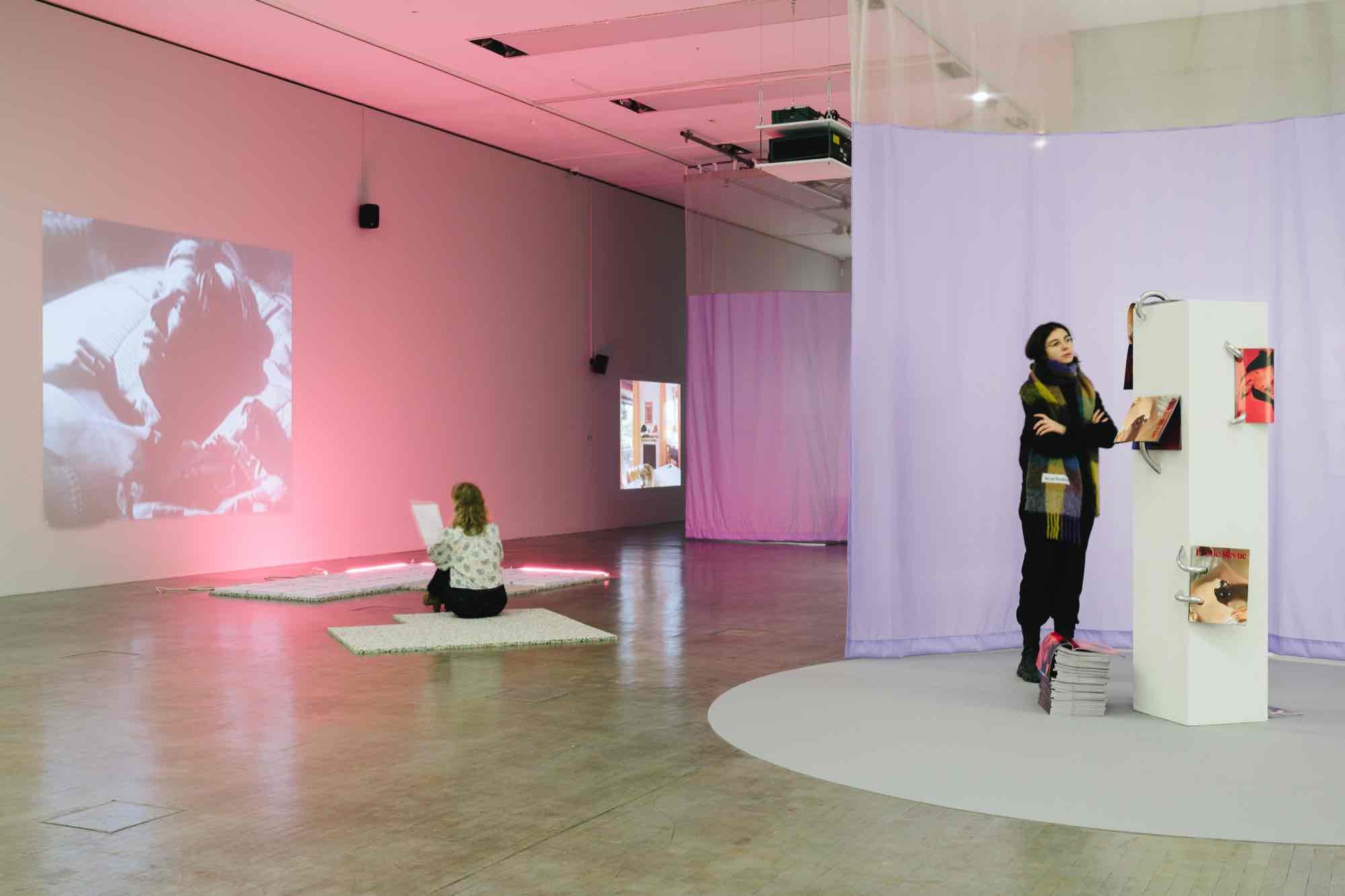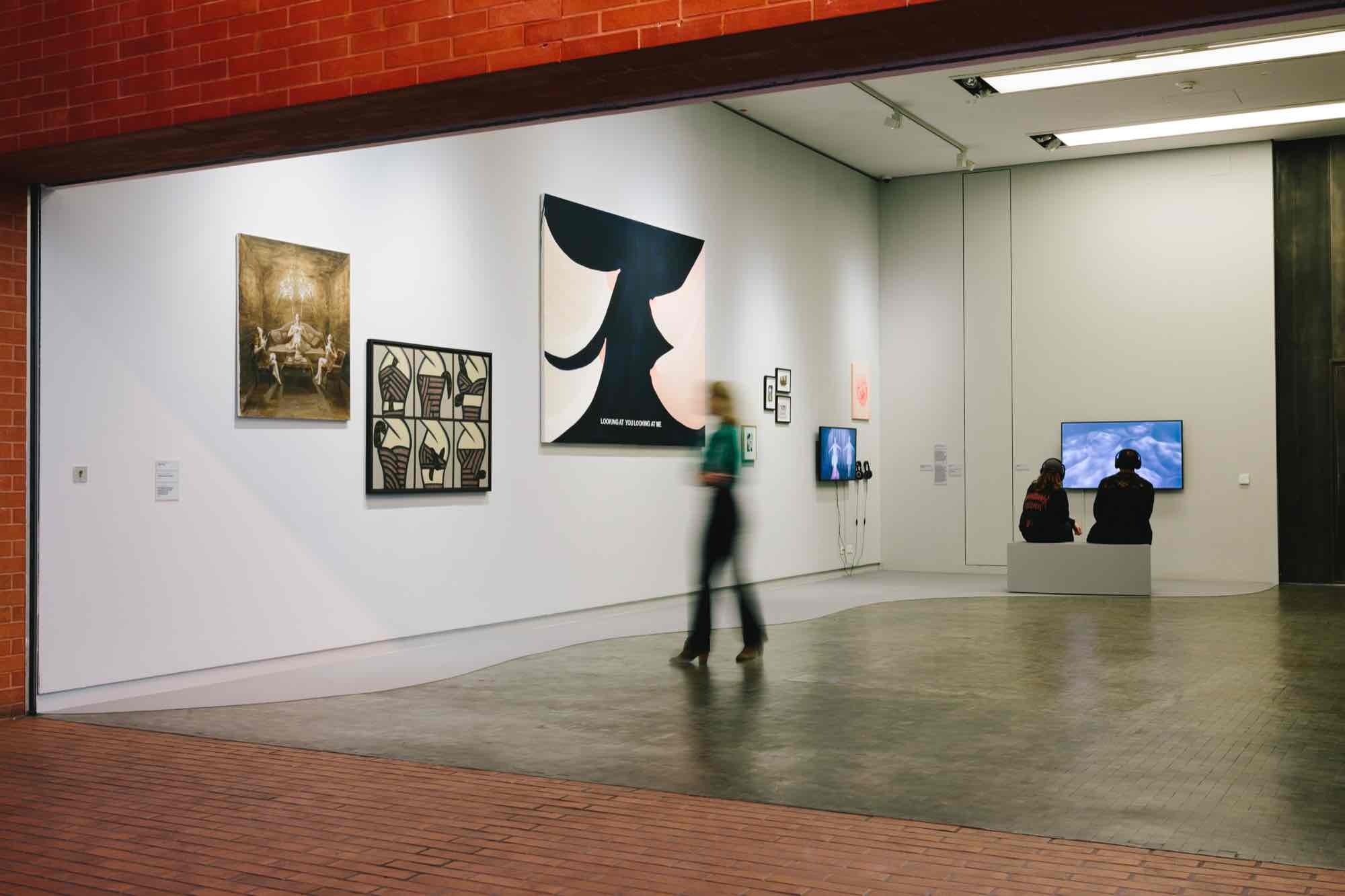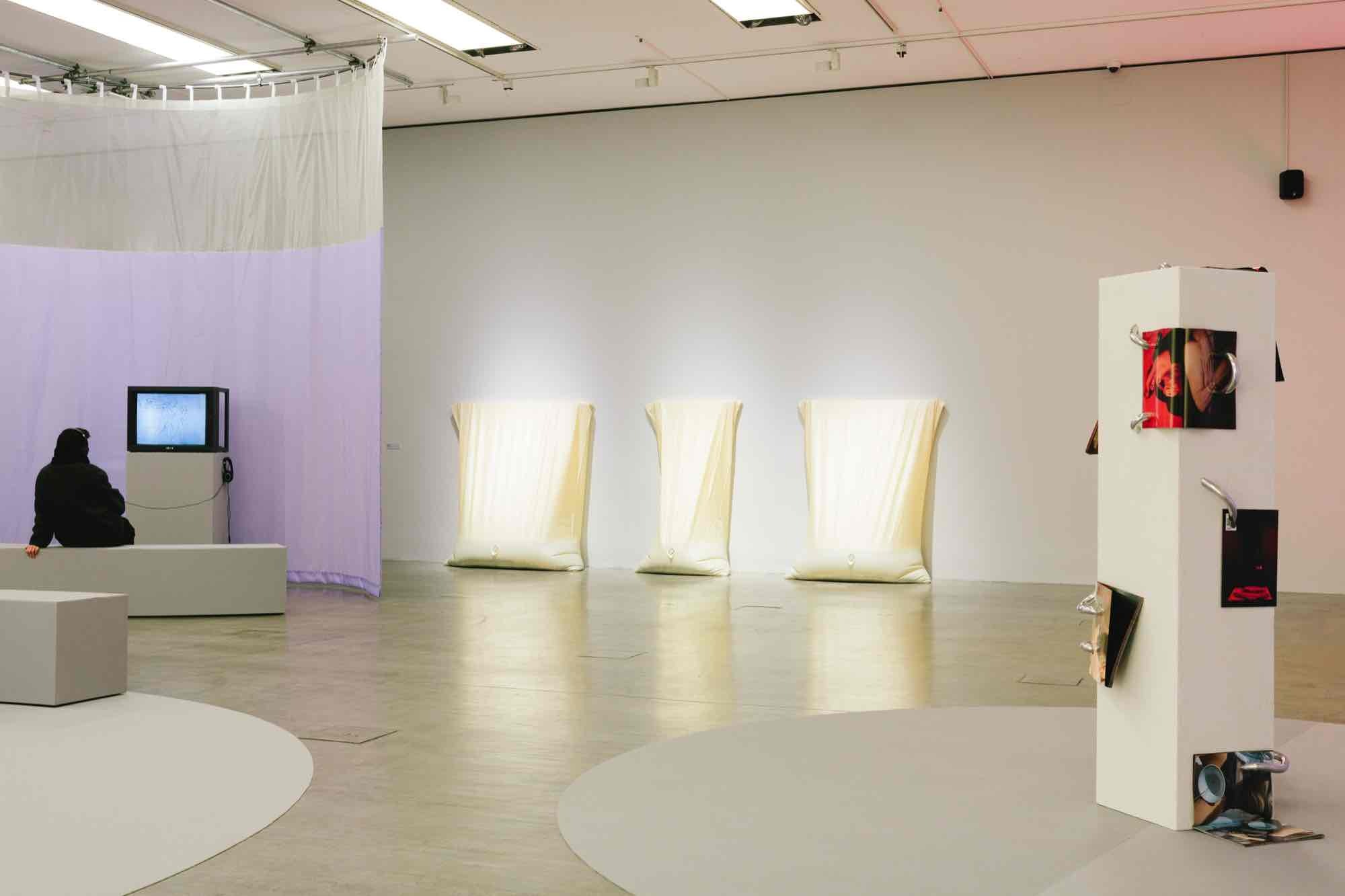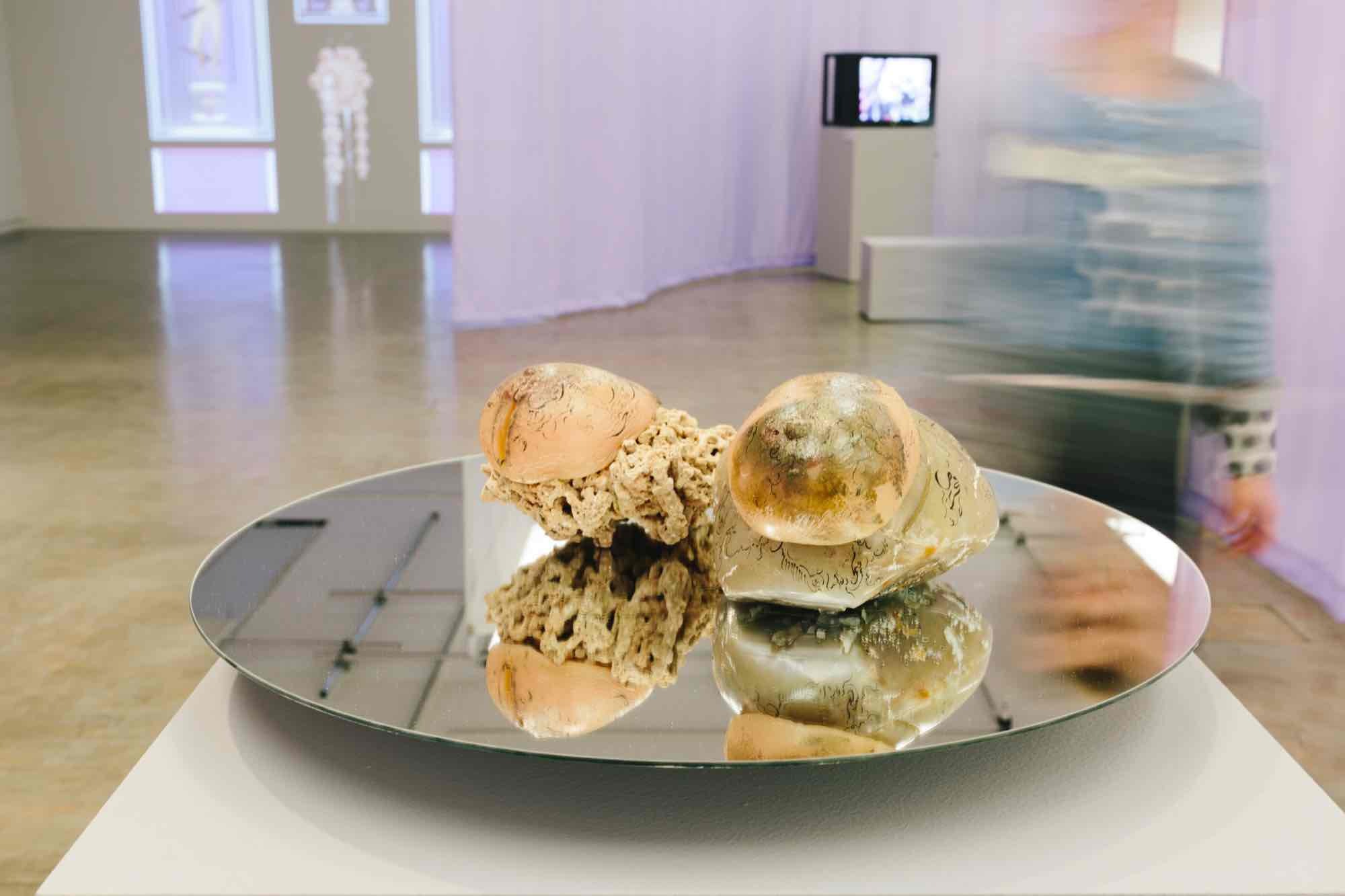Darker, Lighter, Puffy, Flat
29 Nov 2023 - 14 Apr 2024
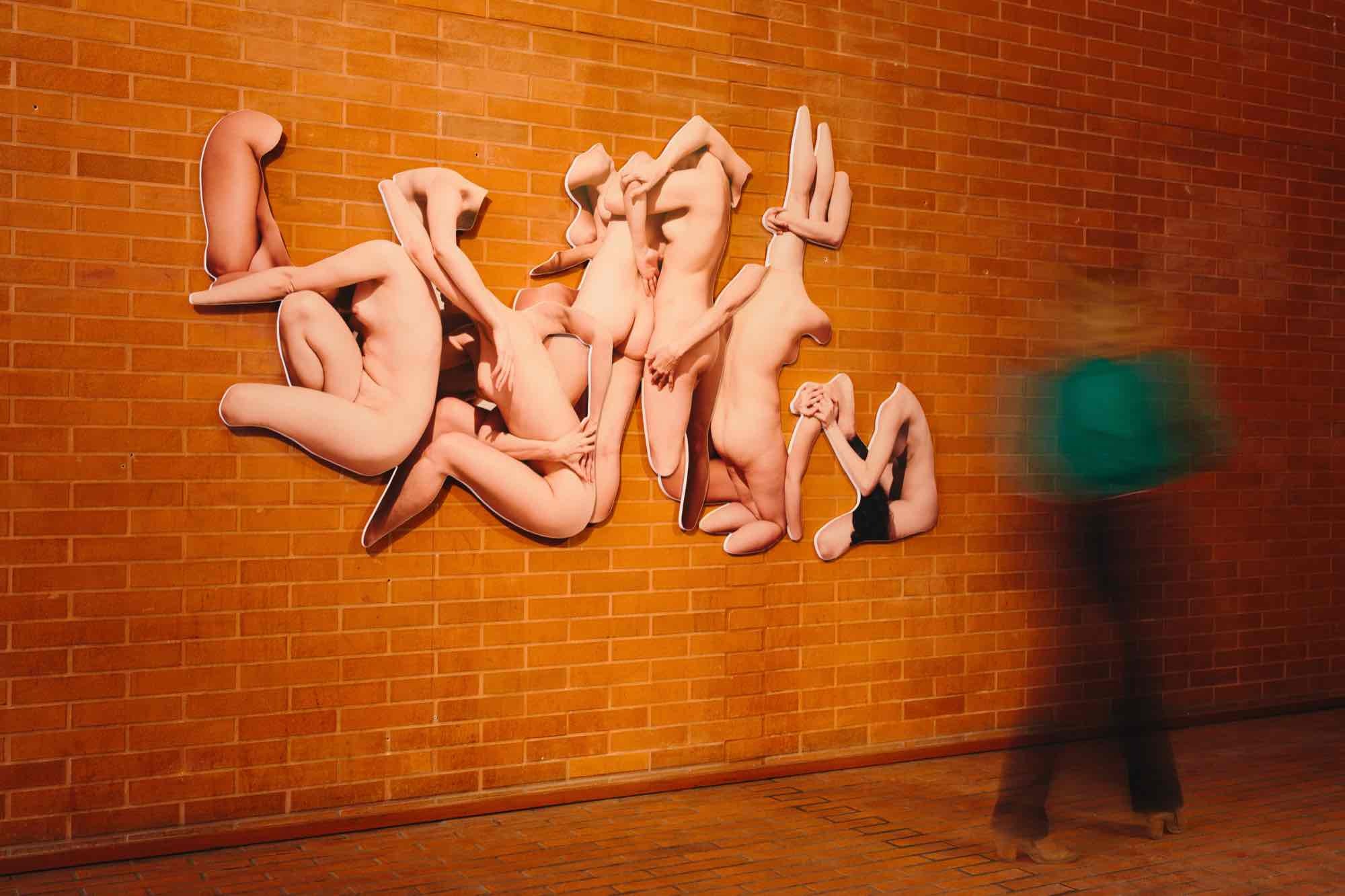
Installation view Darker, Lighter, Puffy, Flat: Dorottya Vékony, Fertility I., 2020, Kunsthalle Wien 2023, photo: Apollonia T. Bitzan

Installation view Darker, Lighter, Puffy, Flat: Mariya Vasilyeva, ALTAR 2.0, 2019, Kunsthalle Wien 2023, photo: Apollonia T. Bitzan / © Bildrecht, Wien 2023

Installation view Darker, Lighter, Puffy, Flat: Misleidys Castillo Pedroso, Untitled, ca. 2016-2022, Kunsthalle Wien 2023, photo: Apollonia T. Bitzan
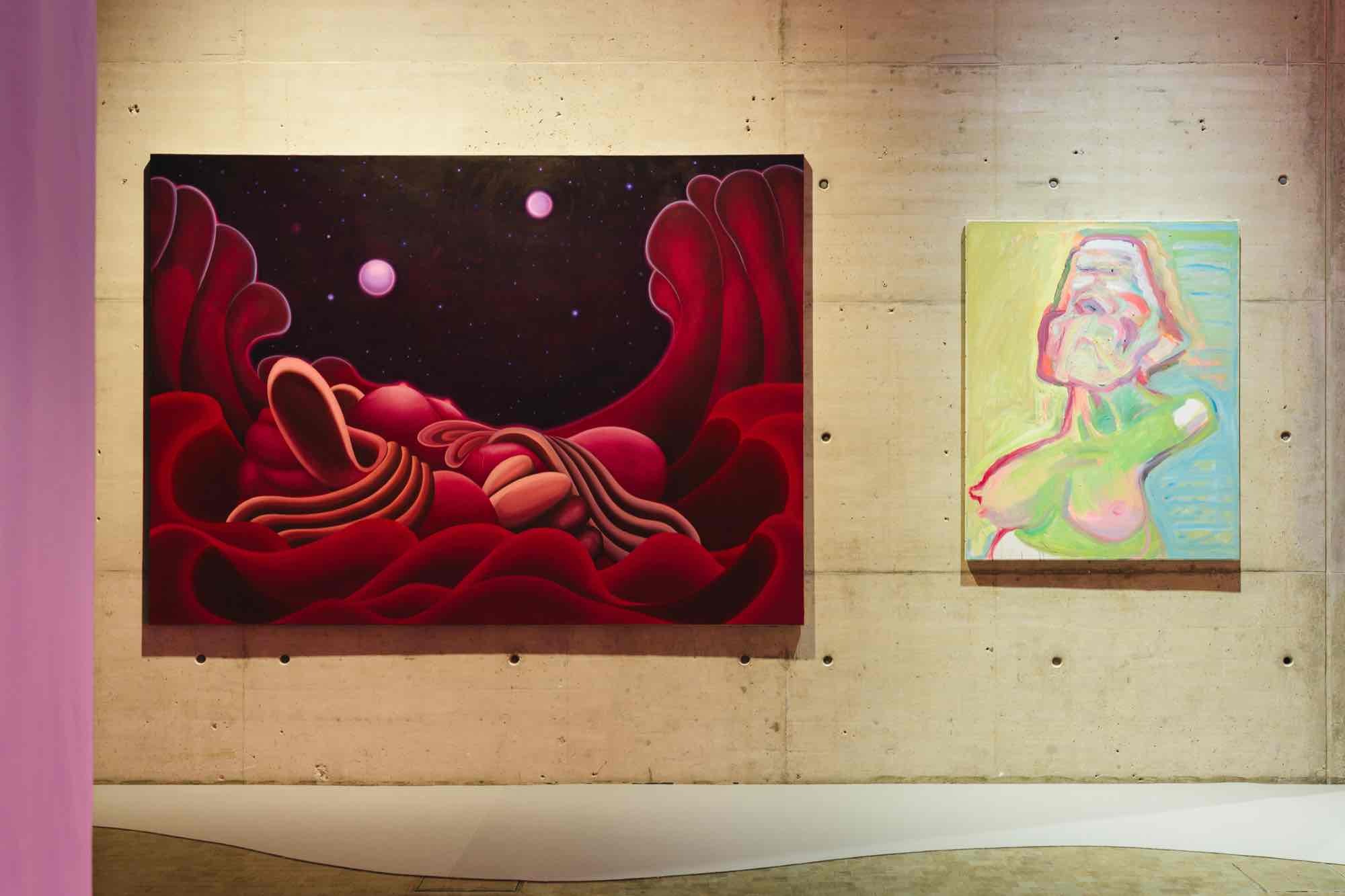
Installation view Darker, Lighter, Puffy, Flat: Marianne Vlaschits, The Deluge, 2023, and Maria Lassnig, Traum vom Idealbusen / Busenwunsch / Busenillusion, 1996–1997, © Maria Lassnig Foundation, Kunsthalle Wien 2023, photo: Apollonia T. Bitzan / © Bildrecht, Wien 2023
The international group exhibition Darker, Lighter, Puffy, Flat looks at the meaning of the human breast in culture, society, and art history. It brings together artists of different generations, new commissions, and previously exhibited works that (in one way or another) explore the breast, the tensions and conflicts it creates, but also its sensuality and its playfulness. Breasts—especially women’s—are in many ways omnipresent in our lives: in advertisements, the portrayal of women in films and video games, and casual references in all kinds of conversations.
As the title of the exhibition suggests, breasts as well as nipples come in a variety of forms: some larger, some smaller, some flatter, some darker, some lighter. For some they are a source of shame and unease; for others they are something to proudly display in public. Whatever our individual experiences—we all have them.
It is against this backdrop that the exhibition looks at the topic of breasts and why they still seem to be the subject of so much scandal and dispute. In a society where we face so many urgent, manmade humanitarian and ecological catastrophes of devastating proportions, why is it that a bare nipple has the power to disrupt algorithms, scandalize onlookers, or be deemed worthy of a lawsuit? Why is being topless at the swimming pool regarded as unseemly for some and others not? Why is it offensive to breastfeed in public, or (beware!) to breastfeed an animal? Why is it newsworthy to have or want bigger breasts, smaller breasts, or no breasts at all?
So why are we still talking about boobs?
Apart from this overarching question, another line of inquiry in Darker, Lighter, Puffy, Flat is the historical and, more specifically, art-historical gaze upon breasts; in recent times they have undergone a transformation from wholesome religious symbol to secularized and sexualized object: breasts embody a striking duality as symbols both of nurturing motherhood and the eroticized female body. This dichotomy gives them considerable influence in shaping our perceptions of gendered bodies.
Thirdly, the exhibition therefore examines how radical, queer, feminist discourses—discussions surrounding top surgeries, including breast enhancement and removal—are marked by their historical implications, too. In a world where certain bodies are not meant to exist, their visibility is an act of resistance but also of exposure. The proud display of nipples and breasts of all shapes, sizes, and colors is an act of normalization but potentially also of sexualization or objectification.
Of course, the male breast has also been scrutinized, albeit not to the same degree as its fleshier counterpart in our still-prevailing binary system of man and woman. Nevertheless, the pressure for men to look a certain way, to have a body that reflects the vision of an athletic, strong, healthy potential partner, has increased, creating a market for surgical enhancement on the one hand and severe mental health issues such as bulimia or anorexia on the other. In a world with a more fluid understanding of genders, roles, and bodies in general, there may be new opportunities for the once-male breast to be a nurturer; caregiver; and sensual, sexual object alike.
In a similar vein, interspecies bonding and caring (through breastfeeding, for instance) seems unheard of, if not taboo; yet both the practice of humans breastfeeding domesticated animals and domesticated animals nursing infants has been identified by anthropologists all over the world. At times it is a practice of survival, medical necessity, or religious meaning, but often it merely symbolizes great love and the close bond between humans and other species.
Our reality is such that the (predominantly female) breast has time and again been fetishized to an extent that it could easily be said, from a contemporary perspective, to be reductionist; revealing of patriarchal, heteronormative narratives of domination; and ultimately simply ridiculous. So perhaps what remains to be asked, in a world where pornography is readily at hand and the promise of pleasure can be bought, is: What is still, or could again be, erotic?
Rather than offering one clear response to all these questions mentioned, Darker, Lighter, Puffy, Flat offers a variety of works, practices, and voices that utilize the seemingly light-hearted, sensual, and wanton motif of breasts to speak to the burningly relevant—and occasionally dark and complex—issues of our era, teetering at the edge of sensuality and discursiveness alike.
Artists: Nina Beier • Misleidys Castillo Pedroso • Lucia Dovičáková • VALIE EXPORT • Bruno Gironcoli • Elisa Giardina Papa • Andrea Éva Györi • Trulee Hall • Monia Ben Hamouda • Šejla Kamerić & Aleksandra Vajd • Maria Lassnig • Claudia Lomoschitz • Tala Madani • Sarah Margnetti • Radha May • Marlie Mul • OMARA Mara Oláh • Abdul Sharif Oluwafemi Baruwa • Laure Prouvost • Christina Ramberg • Adam Rzepecki • Toni Schmale • Maja Smrekar • Mariya Vasilyeva • Dorottya Vékony • Marianne Vlaschits • Rafał Zajko
Curator: Laura Amann
As the title of the exhibition suggests, breasts as well as nipples come in a variety of forms: some larger, some smaller, some flatter, some darker, some lighter. For some they are a source of shame and unease; for others they are something to proudly display in public. Whatever our individual experiences—we all have them.
It is against this backdrop that the exhibition looks at the topic of breasts and why they still seem to be the subject of so much scandal and dispute. In a society where we face so many urgent, manmade humanitarian and ecological catastrophes of devastating proportions, why is it that a bare nipple has the power to disrupt algorithms, scandalize onlookers, or be deemed worthy of a lawsuit? Why is being topless at the swimming pool regarded as unseemly for some and others not? Why is it offensive to breastfeed in public, or (beware!) to breastfeed an animal? Why is it newsworthy to have or want bigger breasts, smaller breasts, or no breasts at all?
So why are we still talking about boobs?
Apart from this overarching question, another line of inquiry in Darker, Lighter, Puffy, Flat is the historical and, more specifically, art-historical gaze upon breasts; in recent times they have undergone a transformation from wholesome religious symbol to secularized and sexualized object: breasts embody a striking duality as symbols both of nurturing motherhood and the eroticized female body. This dichotomy gives them considerable influence in shaping our perceptions of gendered bodies.
Thirdly, the exhibition therefore examines how radical, queer, feminist discourses—discussions surrounding top surgeries, including breast enhancement and removal—are marked by their historical implications, too. In a world where certain bodies are not meant to exist, their visibility is an act of resistance but also of exposure. The proud display of nipples and breasts of all shapes, sizes, and colors is an act of normalization but potentially also of sexualization or objectification.
Of course, the male breast has also been scrutinized, albeit not to the same degree as its fleshier counterpart in our still-prevailing binary system of man and woman. Nevertheless, the pressure for men to look a certain way, to have a body that reflects the vision of an athletic, strong, healthy potential partner, has increased, creating a market for surgical enhancement on the one hand and severe mental health issues such as bulimia or anorexia on the other. In a world with a more fluid understanding of genders, roles, and bodies in general, there may be new opportunities for the once-male breast to be a nurturer; caregiver; and sensual, sexual object alike.
In a similar vein, interspecies bonding and caring (through breastfeeding, for instance) seems unheard of, if not taboo; yet both the practice of humans breastfeeding domesticated animals and domesticated animals nursing infants has been identified by anthropologists all over the world. At times it is a practice of survival, medical necessity, or religious meaning, but often it merely symbolizes great love and the close bond between humans and other species.
Our reality is such that the (predominantly female) breast has time and again been fetishized to an extent that it could easily be said, from a contemporary perspective, to be reductionist; revealing of patriarchal, heteronormative narratives of domination; and ultimately simply ridiculous. So perhaps what remains to be asked, in a world where pornography is readily at hand and the promise of pleasure can be bought, is: What is still, or could again be, erotic?
Rather than offering one clear response to all these questions mentioned, Darker, Lighter, Puffy, Flat offers a variety of works, practices, and voices that utilize the seemingly light-hearted, sensual, and wanton motif of breasts to speak to the burningly relevant—and occasionally dark and complex—issues of our era, teetering at the edge of sensuality and discursiveness alike.
Artists: Nina Beier • Misleidys Castillo Pedroso • Lucia Dovičáková • VALIE EXPORT • Bruno Gironcoli • Elisa Giardina Papa • Andrea Éva Györi • Trulee Hall • Monia Ben Hamouda • Šejla Kamerić & Aleksandra Vajd • Maria Lassnig • Claudia Lomoschitz • Tala Madani • Sarah Margnetti • Radha May • Marlie Mul • OMARA Mara Oláh • Abdul Sharif Oluwafemi Baruwa • Laure Prouvost • Christina Ramberg • Adam Rzepecki • Toni Schmale • Maja Smrekar • Mariya Vasilyeva • Dorottya Vékony • Marianne Vlaschits • Rafał Zajko
Curator: Laura Amann

